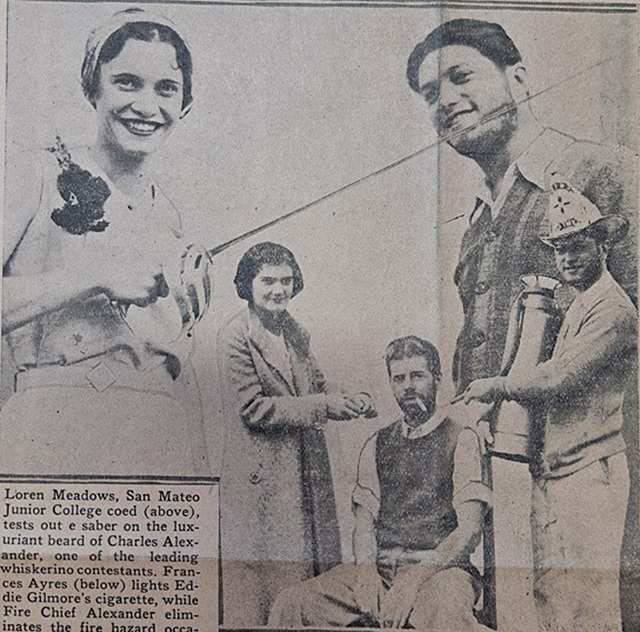Whiskerinos, Daisy Dukes and Smokers
CSM students in decades past found ways to creatively let off steam
For much of the 20th century, the respectable male face was clean-shaven. The respectable male might smoke tobacco, but complex social codes governed when and how.
San Mateo Junior College President Charles S. “Jum” Morris enforced all such codes religiously, believing them vital to a learning environment. College staff and students found ways around the rules. They thought creatively letting off steam helped build community, essential to a learning environment as well.
So, until the 1950s, SMJC’s student government held “whiskerinos,” contests for growing facial hair. For three weeks each spring (when hair, like plants, grows faster), campus men competed to see who could grow the longest mustache or beard. Entry fees helped fund other student activities. Oversight was strict. On Day One of the contest, each contestant was certified baby-face smooth. On Day 21, student leaders measured the growth with meticulous care and awarded prizes to the winners. In 1931, runner-up Eddie Gilmore was hirsutely pictured in the San Matean with another campus taboo, a dangling cigarette.
For another way of letting off steam was the “smoker,” a social event where SMJC men could light up all they wanted.

Normally, Morris banned smoking as too casual for learning—not to mention a fire hazard in the college’s old buildings. Twice a year, though, he allowed all-male “smokers” in such fire-safe venues as, ironically, the Burlingame Women’s Club. Admission bought students and faculty unlimited cigarettes, pipe tobacco and cigars, plus a space to mix as equals in a relaxed environment. Entertainment included a talk by a top sports coach, and, in later years, a car or boat show. These smokers were also where college athletes received their varsity letters. Not until the U.S. Surgeon General’s 1964 report linking tobacco to cancer were smoking’s hazards widely known.
Campus men also gathered to smoke on “Nicotine Bridge,” which spanned San Mateo Creek near the Baldwin Avenue campus.
There were even a few “ladies’ puffers” after CSM moved to Coyote Point, with candy cigarettes available to abstainers.
Students, particularly women, followed a strict dress code that also was allowed rare exceptions. Each year for Sadie Hawkins Day, as part of a charity fundraiser, students competed for the right to dress as their favorite character from the comic strip Li’l Abner. Women could wear jeans or slacks, normally forbidden, but the most sought-after female role was that of Daisy Duke – tiny shorts and all.
In 1963, after CSM’s move to College Heights, the city of San Mateo dismantled Nicotine Bridge to the sorrow of alumni and long-term staff. Smokers, as an event, don’t appear to have survived the move up the hill, in part because the new campus allowed smoking in certain areas. Still, the surgeon general’s report moved CSM President Julio Bortolazzo, over faculty and student outcry, to ban cigarette machines from campus.
The dress code fell in 1966, a couple of years sooner than at many colleges. CSM athletes, if not all campus men, were expected to be clean-shaven for a while longer. That rule was finally smashed by track athletes who grew long hair and mustaches in emulation of 1972 Olympic distance runner Steve Prefontaine, whose flowing locks symbolized strength and freedom.

